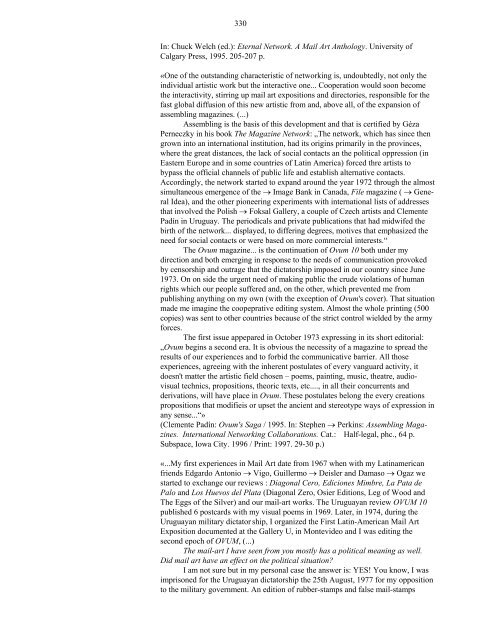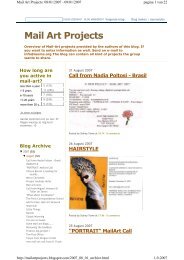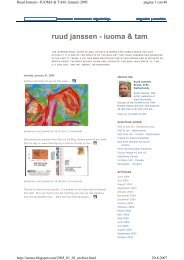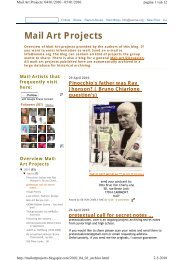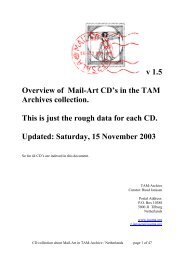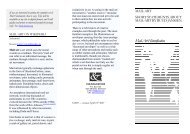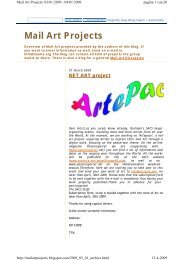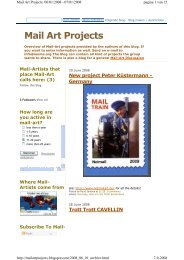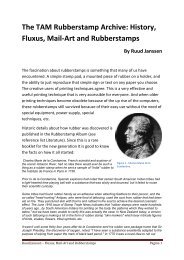Network Atlas by Geza Perneczky - Ruud Janssen
Network Atlas by Geza Perneczky - Ruud Janssen
Network Atlas by Geza Perneczky - Ruud Janssen
You also want an ePaper? Increase the reach of your titles
YUMPU automatically turns print PDFs into web optimized ePapers that Google loves.
330In: Chuck Welch (ed.): Eternal <strong>Network</strong>. A Mail Art Anthology. University ofCalgary Press, 1995. 205-207 p.«One of the outstanding characteristic of networking is, undoubtedly, not only theindividual artistic work but the interactive one... Cooperation would soon becomethe interactivity, stirring up mail art expositions and directories, responsible for thefast global diffusion of this new artistic from and, above all, of the expansion ofassembling magazines. (...)Assembling is the basis of this development and that is certified <strong>by</strong> Géza<strong>Perneczky</strong> in his book The Magazine <strong>Network</strong>: „The network, which has since thengrown into an international institution, had its origins primarily in the provinces,where the great distances, the lack of social contacts an the political oppression (inEastern Europe and in some countries of Latin America) forced thre artists to<strong>by</strong>pass the official channels of public life and establish alternative contacts.Accordingly, the network started to expand around the year 1972 through the almostsimultaneous emergence of the → Image Bank in Canada, File magazine ( → GeneralIdea), and the other pioneering experiments with international lists of addressesthat involved the Polish → Foksal Gallery, a couple of Czech artists and ClementePadín in Uruguay. The periodicals and private publications that had midwifed thebirth of the network... displayed, to differing degrees, motives that emphasized theneed for social contacts or were based on more commercial interests.“The Ovum magazine... is the continuation of Ovum 10 both under mydirection and both emerging in response to the needs of communication provoked<strong>by</strong> censorship and outrage that the dictatorship imposed in our country since June1973. On on side the urgent need of making public the crude violations of humanrights which our people suffered and, on the other, which prevented me frompublishing anything on my own (with the exception of Ovum's cover). That situationmade me imagine the coopeprative editing system. Almost the whole printing (500copies) was sent to other countries because of the strict control wielded <strong>by</strong> the armyforces.The first issue appepared in October 1973 expressing in its short editorial:„Ovum begins a second era. It is obvious the necessity of a magazine to spread theresults of our experiences and to forbid the communicative barrier. All thoseexperiences, agreeing with the inherent postulates of every vanguard activity, itdoesn't matter the artistic field chosen – poems, painting, music, theatre, audiovisualtechnics, propositions, theoric texts, etc...., in all their concurrents andderivations, will have place in Ovum. These postulates belong the every creationspropositions that modifieis or upset the ancient and stereotype ways of expression inany sense...“»(Clemente Padín: Ovum's Saga / 1995. In: Stephen → Perkins: Assembling Magazines.International <strong>Network</strong>ing Collaborations. Cat.: Half-legal, phc., 64 p.Subspace, Iowa City. 1996 / Print: 1997. 29-30 p.)«...My first experiences in Mail Art date from 1967 when with my Latinamericanfriends Edgardo Antonio → Vigo, Guillermo → Deisler and Damaso → Ogaz westarted to exchange our reviews : Diagonal Cero, Ediciones Mimbre, La Pata dePalo and Los Huevos del Plata (Diagonal Zero, Osier Editions, Leg of Wood andThe Eggs of the Silver) and our mail-art works. The Uruguayan review OVUM 10published 6 postcards with my visual poems in 1969. Later, in 1974, during theUruguayan military dictator ship, I organized the First Latin-American Mail ArtExposition documented at the Gallery U, in Montevideo and I was editing thesecond epoch of OVUM, (...)The mail-art I have seen from you mostly has a political meaning as well.Did mail art have an effect on the political situation?I am not sure but in my personal case the answer is: YES! You know, I wasimprisoned for the Uruguayan dictatorship the 25th August, 1977 for my oppositionto the military government. An edition of rubber-stamps and false mail-stamps


